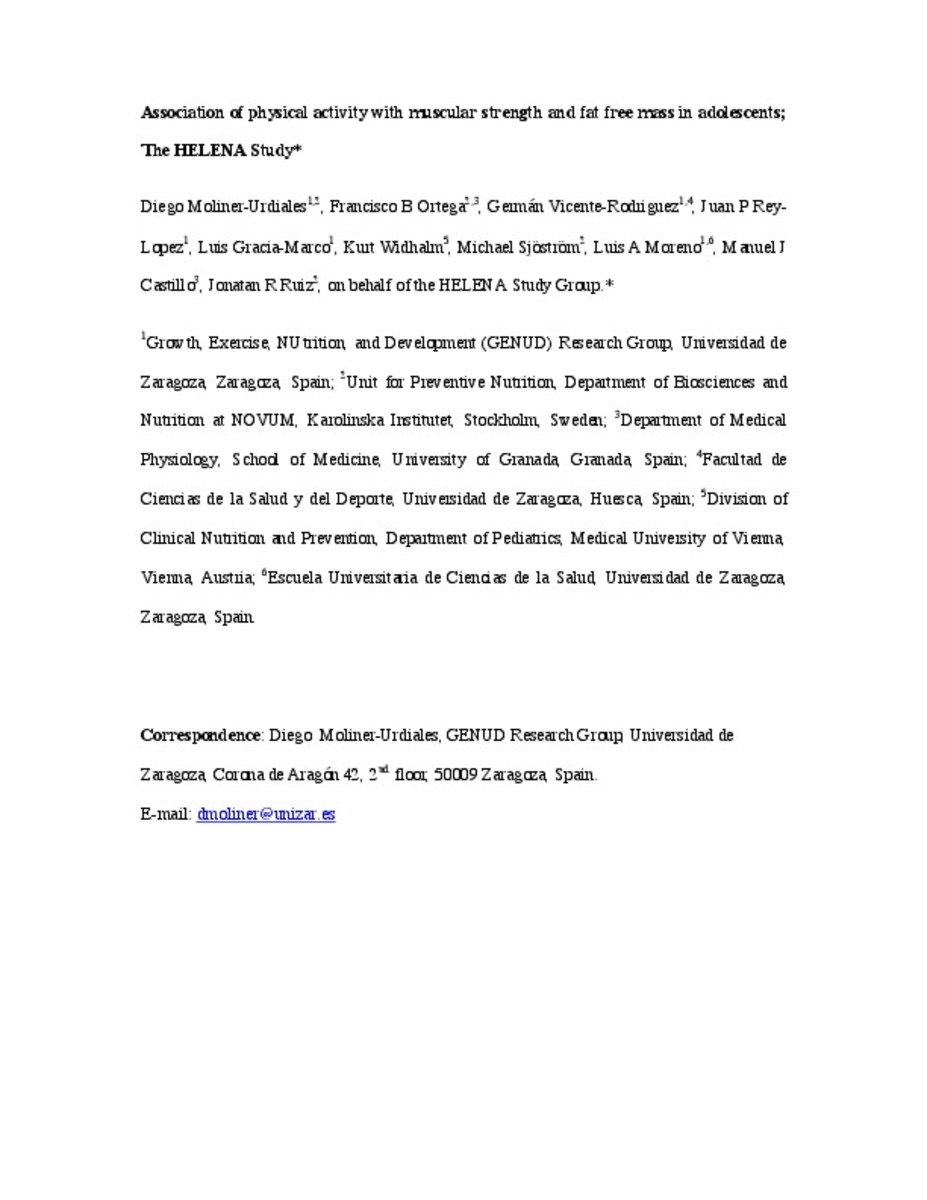| dc.contributor.author | Moliner-Urdiales, Diego | |
| dc.contributor.author | Ortega, Francisco B. | |
| dc.contributor.author | Vicente Rodríguez, Germán | |
| dc.contributor.author | Rey López, Juan P. | |
| dc.contributor.author | Gracia Marco, Luis | |
| dc.contributor.author | Widhalm, Kurt | |
| dc.contributor.author | Sjöstrom, Michael | |
| dc.contributor.author | Moreno, Luis A. | |
| dc.contributor.author | Castillo, Manuel J. | |
| dc.contributor.author | Ruiz, Jonatan R. | |
| dc.date.accessioned | 2012-04-30T07:22:28Z | |
| dc.date.available | 2012-04-30T07:22:28Z | |
| dc.date.issued | 2010 | |
| dc.identifier.citation | European Journal of Applied Physiology and Occupational Physiology (2010) Vol. 109, no. 6, p. 1119-1127 | ca_CA |
| dc.identifier.issn | 1439-6319 | |
| dc.identifier.issn | 1439-6327 | |
| dc.identifier.uri | http://hdl.handle.net/10234/35780 | |
| dc.description.abstract | Objective: To analyze the association of objectively assessed physical activity (PA) with muscular strength and fat free mass in adolescents, and to determine whether meeting the current PA recommendations is associated with higher levels of muscular strength and fat free mass.
Subjects/Methods: The present cross-sectional study comprised 363 Spanish adolescents (180 females) aged 12.5-17.5 years. PA was assessed by accelerometry and expressed as average PA (counts/min), and min/day of inactive, light, moderate, vigorous and moderate to vigorous PA (MVPA). MVPA was dichotomized into <60 min/day and ≥60. Upper body muscular strength was measured with the handgrip strength test, and lower body muscular strength was measured with the standing broad jump, squat jump, counter movement jump and Abalakov tests. Fat free mass was measured by DXA.
Results: We observed positive associations between vigorous PA and all the lower body muscular strength tests except for the counter movement jump in males. PA was not associated with fat free mass in both males and females. Male adolescents engaged in at least 60 min/day MVPA performed better in the standing broad jump test.
Conclusions: The findings of the present study suggest that only vigorous PA is associated with muscular strength, particularly lower-body muscular strength in male adolescents. | ca_CA |
| dc.format.extent | 27 p. | ca_CA |
| dc.format.mimetype | application/pdf | ca_CA |
| dc.language.iso | eng | ca_CA |
| dc.publisher | Springer Verlag | ca_CA |
| dc.relation.isFormatOf | Versió preprint del document publicat a: http://www.springerlink.com/content/1439-6319/ | ca_CA |
| dc.rights.uri | http://rightsstatements.org/vocab/CNE/1.0/ | * |
| dc.subject | Physical activity | ca_CA |
| dc.subject | Muscular strength | ca_CA |
| dc.subject | Fat free mass | ca_CA |
| dc.subject | Accelerometer | ca_CA |
| dc.subject | Adolescents | ca_CA |
| dc.subject.lcsh | Exercise | ca_CA |
| dc.subject.lcsh | Weight training | ca_CA |
| dc.subject.lcsh | Obesity in adolescence | ca_CA |
| dc.subject.other | Exercici | ca_CA |
| dc.subject.other | Musculació | ca_CA |
| dc.subject.other | Obesitat en els adolescents | ca_CA |
| dc.title | Association of physical activity with muscular strength and fat free mass in adolescents; The HELENA Study | ca_CA |
| dc.type | info:eu-repo/semantics/article | ca_CA |
| dc.rights.holder | © Springer Verlag | |
| dc.identifier.doi | http://dx.doi.org/10.1007/s00421-010-1457-z | |
| dc.rights.accessRights | info:eu-repo/semantics/openAccess | ca_CA |







